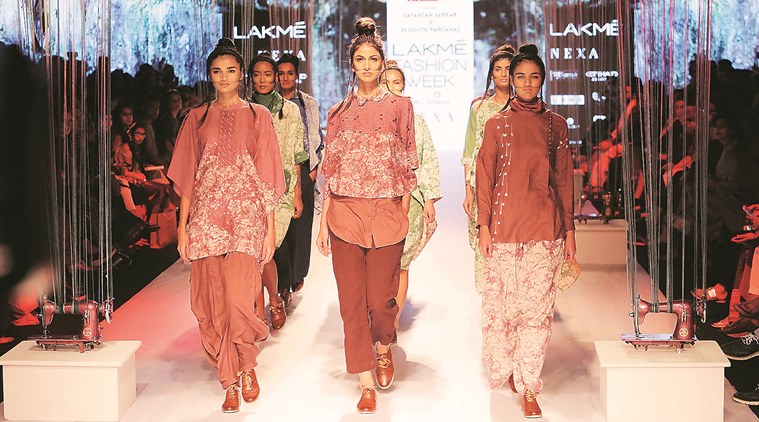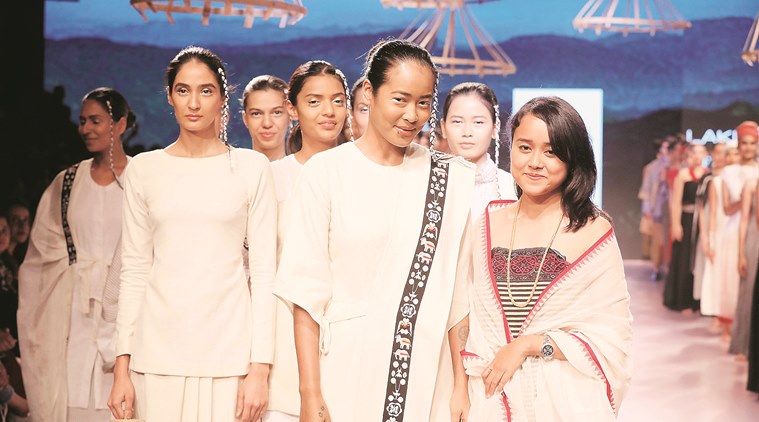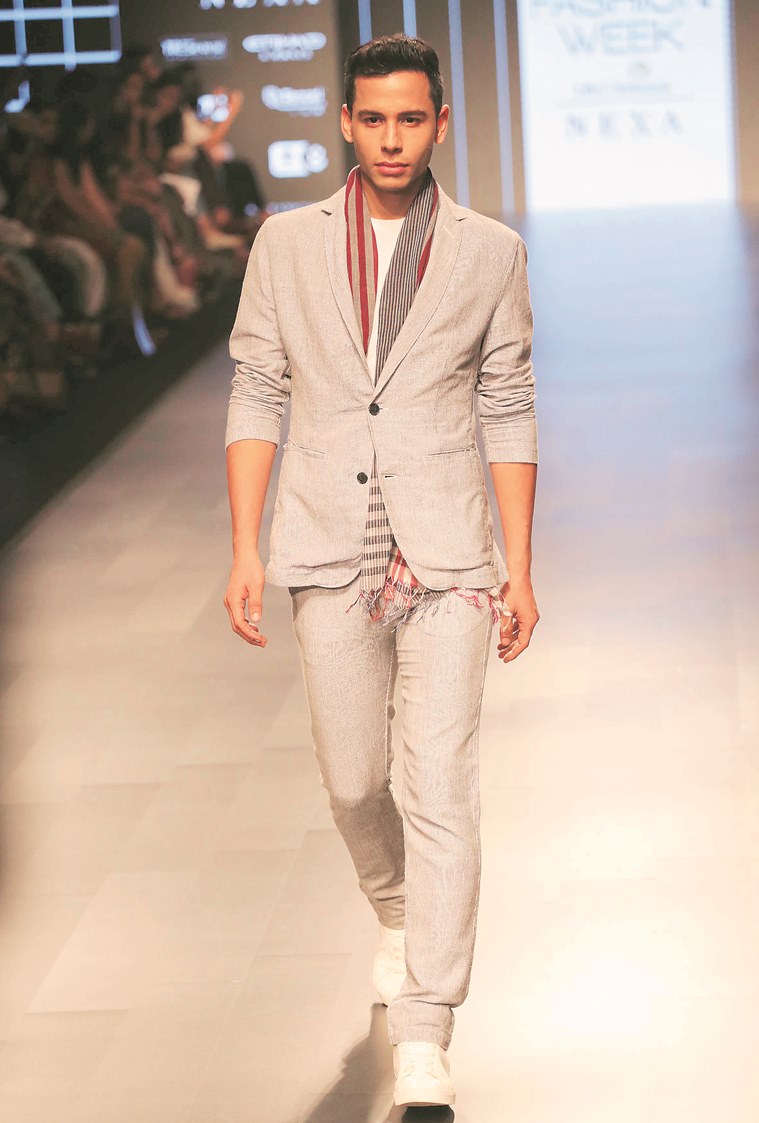- India
- International
Lakme Fashion Week Summer/Resort 2018: The fabric of life
Day Two at the Lakme Fashion Week brought weavers, craftspeople and designers together to create meaningful fashion
 Richana Khumanthem with her models (Amit Chakravarty)
Richana Khumanthem with her models (Amit Chakravarty)
ONE OF fashion’s oft-used and much abused terms — collaboration — became the buzzword for Day Two of Lakme Fashion Week’s (LFW) Summer/Resort 2018 edition. And while the fashion fraternity normally bandies this word around for designer-brand alliances peddling everything from footwear, lipsticks, watches, even ‘Kurkure’ packaging, on Sustainable Fashion Day, several creative collaborations lent credence to the proceedings.
The day dedicated to India’s handlooms and indigenous textiles saw the event curators continue to chart the course they’d set last year, when they brought young designers and master craftsmen of Paramparik Karigar together in the highly lauded #CraftisCool show. Only, this time the opening show of the day saw designers from the Northeast join hands with handloom clusters from the region and present collections steeped in their cultural, textile and tribal traditions.
While Assam’s Eri or Ahimsa silk, muga silk and pat silk woven by the Sualkuchi cluster found their way to designer Sonam Dubal’s autumn-winter 2018 creations, the ramp show #NortheastMojo saw Richana Khumanthem, of the label Khumanthem, present her take on the traditional pure cotton Wanhkei Phee handloom fabric woven by the Meitei of Manipur. Daniel Syiem presented “ShaKiLum”, using heritage textile Ryndia woven by artisans from the RiBhoi district of Meghalaya.
 Sayantan Sarkar worked with silai women from 24 Parganas on the Usha Silai label collection
Sayantan Sarkar worked with silai women from 24 Parganas on the Usha Silai label collection
Similarly, Nagaland saw representation in Jenjum Gadi’s collaboration with Exotic Echo Society and their use of the local backstrap weaving method called loinloom; Karma Sonam of Kuzu employed Lepcha, Sikkim’s weaving technique with nettle, organic cotton and yak and Merino wool, and Aratrik Dev Varman of Tilla reimagined the Tripuri Riahs or breast cloths worn by women of 19 tribes of the state. Each designer incorporated local flavour and tribal references in the form of silhouettes, motifs, prints and accessories, yet not overshadowing the contemporary narrative.
The show was a fitting flagbearer to IMG Reliance’s Crafting Futures programme with The British Council and Fashion Revolution, an initiative that will see Varman and British designer Bethany Williams working towards creating economic opportunities for women textile artisans of the Northeast.
This collaborative theme ran through the day, as Padmaja Krishnan’s creations used khadi and linen from Maheshwar-based NGO Gudi Mudi. GoCoop.com, an online marketplace that enables handloom cooperatives and artisans to connect with consumers, presented The Good Loom, a ready-to-wear menswear line of shirts, trousers, stoles and pyjamas.

But it was the curtainraiser show of the Usha Silai label, created by the sewing machine manufacturer in conjunction with IMG Reliance, which brought the #ReimagineFashion message home. Label Usha Silai teamed four designers with women workers from different clusters of their silai school network to create collections.
While Ahmedabad-based Soham Dave worked with the silai women of Dholka (Gujarat), Amit Vijaya and Richard Pandav were teamed with the Kaladera cluster in Rajasthan, Sreejith Jeevan of Rouka was paired up with the Puducherry cluster and Sayatan Sarkar collaborated with the 24 Parganas Mastikari cluster of West Bengal. While the show was not really a revelation in terms of design and style strength, we loved how each designer drew inspiration from local costumes as variations of kedia tops, kanjari blouses, angarakha necklines, lehengas and dhoti pants walked the ramp. LFW’s hashtag #MakeFashionGood might have sounded a tad sanctimonious, but at the end of the show, when silai women took the curtain call with designers, one wanted to believe in the pipe dream.
 an outfit from GoCoop’s ‘The Good Loom’ line
an outfit from GoCoop’s ‘The Good Loom’ line
While Ogaan has signed up as exclusive retail partner to launch the Usha Silai collections, are fashion’s facile collaborations enough to build sustainable economies on? Yes, believes Gautam Vazirani, curator, IMG Reliance. “Sustainable fashion in India is not just about eco-friendly, organic fabrics cut in a certain way, it’s about bringing the smallest producers to the forefront, giving them empowerment opportunities, opening up the supply chain model and creating something that everyone can buy and consume,” he says.
And Vazirani is hopeful these collaborations will sustain. “Poochki, who collaborated on Dabu block-prints with Bherulal Chippa for the #CraftIsCool show, is already working on their second season. Kutchi master weaver Chaman Siju has seen a change in his conceptual approach and his sales have increased,” he says. Jeevan, whose label Rouka has continued its work in natural dyes with Aranya Naturals of Kerala for two seasons now since the #CraftIsCool show, believes collaborations need effort to succeed in the long run. “It’s about building relationships with people with different skillsets, not just about co-branding. If this mechanism works it can be a good sustainable model for the industry,” he says.
More Lifestyle
Apr 24: Latest News
- 01
- 02
- 03
- 04
- 05


































